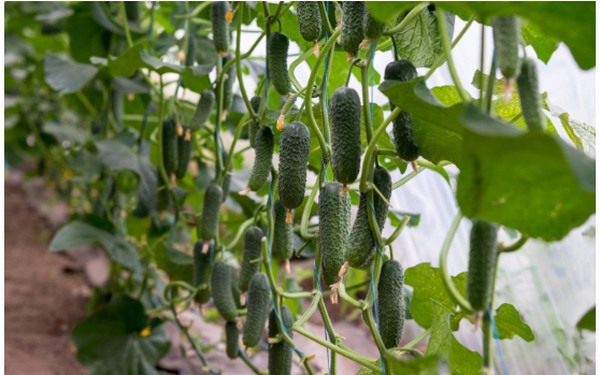Considered to be native to southern Asia, cucumbers are vine crops that grow best under conditions of high light, temperature, and humidity, fortified by a generous supply of water and nutrients. Their optimal photoperiod is 16 to 20 hours, and they prefer daily high temperatures between 75 to 73 and 80 °F (23 and 27 °C) with lows between 60 and 70°F (19-17 and 21°C).
There are many options for staging your greenhouse for cucumbers, depending on the variety and type of growing system. as they can be trellised or hung. But keep in mind that they need ample grow space, so plant density is a key consideration. Your training and pruning practices will also influence plant density, which in turn will affect many factors that are critical to crop growth and yield, including the light your plants receive. The optimal plant density is ultimately dependent on the available level of light since light is a key limiting factor for cucumbers. Crop quality and quantity will decline if your plants are not receiving the light they need.

Greenhouse cucumbers and light
When optimizing the light for greenhouse cucumbers, you first need to consider the natural light that will reach your plants. When natural light levels are low, it may be beneficial to add supplemental lighting. The light that shines into your facility plus the supplemental light you provide to crops in a 24-hour period comprises the total Daily Light Integral (DLI). DLI is a measure of the sum of the Photosynthetically Active Radiation (PAR) that plants use for photosynthesis over the course of a day. While cucumbers can tolerate a wide DLI range to be salable, they develop best under a DLI of 20 to 35 moles or even higher.
Greenhouse cucumbers derive the most benefit from supplemental lighting during the winter months when natural sunlight is in limited supply. But you may also need to supplement the light in other seasons, depending on your geographic area, weather patterns, shaded areas in your greenhouse, and more.
Overall, increasing the light available to cucumbers has been directly related to increases in production – even under high-light conditions in a greenhouse. While increasing DLI generally increases biomass and fruit, every plant has a threshold beyond which further light exposure may produce diminishing returns.
Light quality
In addition to needing light in the right quantity and duration, our in-house research has shown that cucumbers are affected by changes in the quality, or spectra, of light they receive. Some cucumbers are sensitive to far-red (FR) and fail to develop normal morphology when FR is excluded from the spectrum. Other parts of the spectrum and the balance between them have also shown to have an impact on cucumbers, like the blue-to-green ratio.
For more information: 
Heliospectra
info@heliospectra.com
www.heliospectra.com
